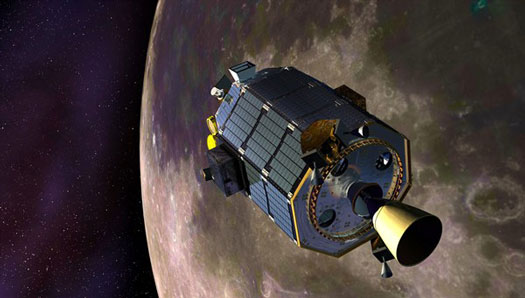| Mar 06, 2014 |
Laser beam from the Moon to Earth
|
|
(Nanowerk News) By the time the signal is analysed by scientists at the German Aerospace Center (Deutsches Zentrum für Luft- und Raumfahrt; DLR), it will have travelled roughly 400,000 kilometres and passed through Earth's atmosphere. They discover that: "The atmosphere has a less pronounced influence than expected; the signal quality is very good," says Dirk Giggenbach from the DLR Institute of Communications and Navigation. The signal was transmitted by the Lunar Lasercom Space Terminal (LLST) on board the NASA spacecraft Lunar Atmosphere and Dust Environment Explorer (LADEE), which has been orbiting the Moon since October 2013. This is the first time that an optical link has been analysed after a long passage through space. Future lunar and planetary missions may benefit from this kind of data transmission and the rovers could provide high-resolution, real-time images in 3D.
|
 |
| NASA orbiter LADEE at the Moon.
|
|
The team from the Institute of Communications and Navigation gained experience with the sensors and algorithms used in the analysis during tests conducted on the transmission of laser signals from an aircraft and a number of satellites in low-Earth orbit. Now, optical communications technology has been tested under real space conditions with a lunar orbiter. "For most of its journey, the laser beam travels without disturbance, but passing through Earth's atmosphere at the end of its travels causes substantial signal distortion and attenuation." The DLR researchers used sensors to analyse the disturbance and hence characterise the transmission channel. "Only in this way can we assess how to improve the laser transmission and which losses we simply have to accept."
|
|
Technology for future missions
|
|
Three optical ground stations – the US stations at White Sands and Table Mountain, and the European Space Agency (ESA) station on Tenerife – received data during the Lunar Laser Communication Demonstration (LLCD) experiment. The tests are part of a cooperative project by NASA, the Massachusetts Institute of Technology (MIT), ESA and DLR.
|
|
There is considerable interest in the new technology; communications via radio and microwaves – the technologies used to date – are approaching the limits of their capacity. Optical carrier frequencies, with their shorter wavelengths, offer higher data rates. The Blu-ray version of the Hollywood movie Apollo 13, which has 36,800 megabytes of data, would take just 7.9 minutes to be transmitted from the Moon to Earth via the optical link. If the orbiter were to use its S-band connection to transmit the film to Earth, the researchers would have to wait almost 639 hours – almost an entire month – to receive the data. "Future missions can benefit greatly from optical communication, simply because more data can be transmitted to Earth in less time," asserts Giggenbach.
|

